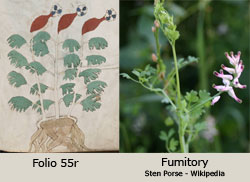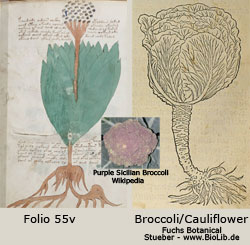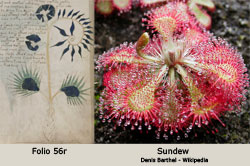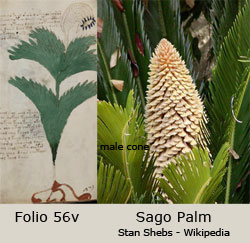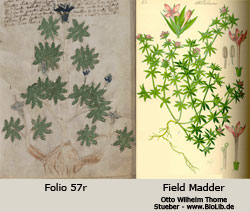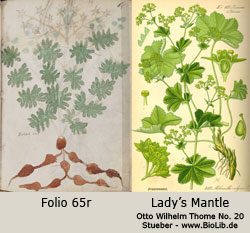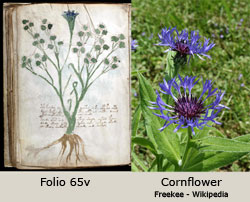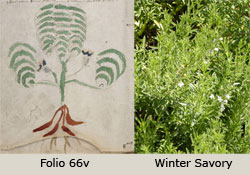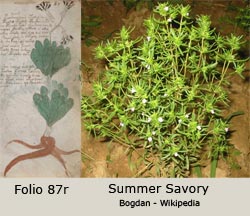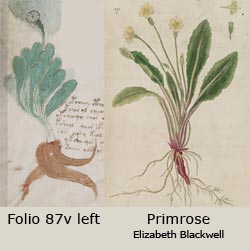The Voynich Botanical Plants
Folio 55r, Fumitory (Fumaria officinalis), is a toxic, annual herb native to temperate regions of Europe and Asia. It may be either erect or trailing and has a taproot. The oval leaves are deeply segmented and the small, pink flowers are tubular. It was used externally in an antiseptic and anti-inflammitory lotion for acne and exema, and also to fade freckles.
Folio 55v, Cauliflower or Broccoli, two vegetables that closely resemble each other and were probably developed in Roman times from wild or primitive forms of cabbage, a native of the Eastern Mediterranean region. Both broccoli and cauliflower have large, fleshy flower heads, sprouting from a thick edible stalk. The large mass of flower heads are surrounded by leaves. Pliny, the Elder, wrote about a vegetable that fits the description of broccoli.
Folio 56r, Sundews (Drosera species), are carnivorous plants, native to all continents except Antartica. VM folio 56r was identified as being a Sundew species by Denis Barthel (Wikipedia). These plants capture and digest insects using stalked, mucilaginous glands that cover their leaf surface. Their leaves are arranged in a rosette, generally flat on the ground, and the flower spike has white flowers (outlined with blue in folio 56r) that usually open one at a time. Sundews were used as medicinal herbs as early as the 12th century, when an Italian doctor, Matthaeus Platearius, described the plant as an herbal remedy for coughs under the name "herba sole." A good drawing of the plant can be found at the Aittakorpi school Web site.
Folio 56v, Sago Palm (Cycas revoluta), is native to the Old World tropics. However, fossils of this palm have been found on almost every continent on the planet. It is an ancient plant that is either male or female. Folio 56v probably represents a male sago palm with a cone. This palm is very slow growing and the trunk can branch multiple times, thus producing multiple heads of leaves. China is reputed to have a 1,000-year-old sago palm.
Folio 57r, Blue Field Madder (Sherardia arvemsis), is an annual, mat-forming herb that is native to Europe. The lanceolate leaves are whorled with 4 to 6 at each node. The flowers occur in clusters at the ends of the stems. A red dye can be obtained from blue field madder and its sweet scent makes it useful in pot pourris. Blue field madder is very similar to woodruff (Galium odoratum), except that the latter has a white flower.
Folio 65r, Ladies Mantle (Alchemilla vulgaris), is native to cool temperate regions of Europe. It is an herbaceous perennial with leaves like rounded fans, covered with fine hairs. Sprays of small, yellow flowers without petals bloom in the late spring. Nicholas Culpeper claimed that the juice of this plant could firm up sagging breasts, and pillows stuffed with its leaves could bring on a good sleep.
Folio 65v, Cornflower (Centaurea cyanus), is native to Europe. It is a tall, slender, branched plant with narrow, lancet-shaped, alternate leaves covered with white hairs. The flowers have pale purple disc florets surrounded by bright blue ray florets that form the conspicous part of the flower. The pigment extracted from the flowers is mixed with alum-water to create an ink. The English herbalist, Culpepper, considered that the seeds or leaves taken in wine would ward off the plague and all infectious diseases.
Folio 66v, Winter Savory (Satureja montana), is a perennial, low-growing, aromatic shrub that is native to the Mediterranean region. The woody stems are branched; the leaves oblong and linear; and the pale purple flowers form whorls on the stems. Savory plays an important part in Italian cuisine, and is used with bean cooking and made into a “mint sauce” with vinegar. Pliny used the old Latin name Satureia describe the plant.
Folio 87r, Summer savory (Satureja hortensis), is a native of the Mediterranean regions and is generally used in Italian cuisine to flavor bean dishes. Bunches of linear oblong leaves are attached directly to the slender erect stems and the pale lilac flowers with a green-tubed calyx, are attached by short stems, often in groups of three, to the main stem. Petrus Crescentius, the thirteenth century Italian author who wrote a treatise on farming and gardening, recommended savory as a remedy for liver and lung complaints.
Folio 87v left, Primrose (Primula vulgaris), is a common Spring flower native to Central and Southern Europe. Its common name is derived from the Medieval Latin, “prima rosa,” meaning “first rose.” The plant has knotty roots with branched rootlets; the leaves are egg-shaped and oblong; each flower is on a separate stalk having a green-tubed calyx; and the pale yellow, tube-shaped corolla ends in five semi-fused petals. Pliny regarded the primrose as an important remedy for muscular rheumatism, paralysis, and gout and primrose leaves were used as potherbs during the middle ages.
